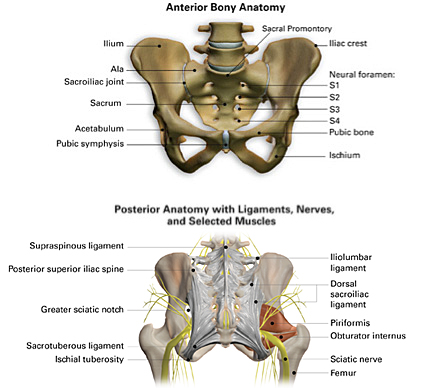Learn
Where and What Is the SI Joint?

SI Joint Anatomy and Function: Does It Move?
The SI joint is stabilized by a network of ligaments and muscles, which also limit motion. The normal sacroiliac joint has a small amount of normal motion of approximately 2-4 mm of movement in any direction. So yes, it moves a little.
The sacroiliac ligaments in women are less stiff than in men, which allows the mobility necessary for childbirth. Motion (primarily rotation) decreases with aging, and increased motion is associated with pregnancy.
SI Joint Shape, Size, and Texture: It's a Real Joint
The SI joint is a true diarthrodial joint, the most common and moveable joint in the body. The articular surfaces are ear shaped, containing irregular ridges and depressions. Its concave sacral surface is covered with thick hyaline cartilage and its convex iliac surface is lined with thin fibrocartilage.
In the upper portion of the joint, the sacrum and the ilium are not in contact but rather are connected with powerful posterior, inter-osseous, and anterior ligaments. The anterior and the lower half of the joint is a typical synovial joint with hyaline cartilage on the joint surfaces.
The SI joint is an axial joint with an approximate surface of 17.5 square cm. The joint surface is smooth in juveniles and becomes irregular over time.
SI Joint Strain, Injury, and Instability
Once you understand where the SI joint is located and what it is, it's easier to understand how it can be injured or degenerate over time and cause low back or spine, pelvic, leg, or buttock pain.
Common Causes of SI Joint Dysfunction and Pain
Mechanical strain and injury to the SI joint are produced by either a combination of vertical compression and rapid rotation (i.e. carrying a heavy object and twisting), or by falls on the backside. Injuries of this type can produce ligamentous laxity and allow painful abnormal motion, in other words, SI joint pain.
Instability of the sacroiliac joint can also arise from lumbar spine surgery in which a large portion of the ilio-lumbar ligament is injured.
SI joint pain can also be caused by leg length discrepancy, gait abnormalities, prolonged, vigorous exercise, trauma, traumatic birth, and long scoliosis fusions to the sacrum.
Painful sacroiliac joint arthritis can also arise from autoimmune disorders, such as ankylosing spondylitis, juvenile rheumatoid arthritis, Reiter’s Syndrome, psoriatic arthritis, and infections including staphylococcus, gonorrhea and TB.
Do you have SI joint pain? Talk to a doctor trained in SI joint diagnosis and treatment.
Need More Help?
More Related Resources
Here's a quiz to determine whether your SI joint is a contributor to pain in your lower back, pelvic region, buttocks, or legs.
More links and information regarding the diagnosis and treatment of SI Joint Pain:

